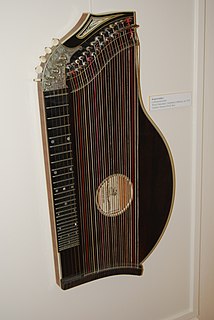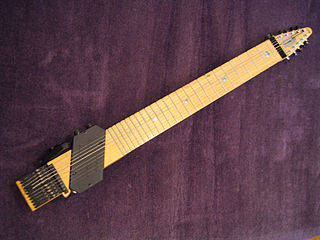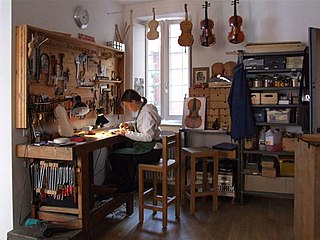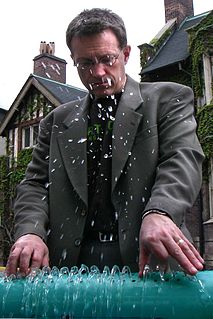Related Research Articles

String instruments, stringed instruments, or chordophones are musical instruments that produce sound from vibrating strings when the performer plays or sounds the strings in some manner.

A fret is a raised element on the neck of a stringed instrument. Frets usually extend across the full width of the neck. On most modern western fretted instruments, frets are metal strips inserted into the fingerboard. On some historical instruments and non-European instruments, frets are made of pieces of string tied around the neck.

Zither is a class of stringed instruments.

The Chapman Stick is an electric musical instrument devised by Emmett Chapman in the early 1970s. A member of the guitar family, the Chapman Stick usually has ten or twelve individually tuned strings and is used to play bass lines, melody lines, chords, or textures. Designed as a fully polyphonic chordal instrument, it can also cover several of these musical parts simultaneously.

Tapping, also called tap style (tapstyle), touch-style, and two-handed tapping, is a guitar playing technique where a string is fretted and set into vibration as part of a single motion of being tapped onto the fretboard, with either hand, as opposed to the standard technique of fretting with one hand and picking with the other. Tapping is the primary technique intended for some instruments such as the Chapman Stick, and is the alternative method for the Warr Guitar and others. Tapped passages incorporate the techniques of hammer-on and pull-off, but with both hands freed to produce notes. Some players rely extensively or exclusively on tapping.
The fingerboard is an important component of most stringed instruments. It is a thin, long strip of material, usually wood, that is laminated to the front of the neck of an instrument. The strings run over the fingerboard, between the nut and bridge. To play the instrument, a musician presses strings down to the fingerboard to change the vibrating length, changing the pitch. This is called stopping the strings. Depending on the instrument and the style of music, the musician may pluck, strum or bow one or more strings with the hand that is not fretting the notes. On some instruments, notes can be sounded by the fretting hand alone, such as with hammer ons, an electric guitar technique.

The Appalachian dulcimer is a fretted string instrument of the zither family, typically with three or four strings, originally played in the Appalachian region of the United States. The body extends the length of the fingerboard, and its fretting is generally diatonic.

A luthier is a craftsperson who builds and repairs string instruments that have a neck and a sound box. The word "luthier" is originally French and comes from the French word for lute. The term was originally used for makers of lutes, but it came to be used already in French for makers of most bowed and plucked stringed instruments such as members of the violin family and guitars. Luthiers, however, do not make harps or pianos; these require different skills and construction methods because their strings are secured to a frame.

Orville H. Gibson was a luthier who founded the Gibson Guitar Company in Kalamazoo, Michigan in 1902, makers of guitars, mandolins and other instruments.
An extended-range bass is an electric bass guitar with a wider frequency range than a standard-tuned four-string bass guitar.
Phillip J. Petillo was an American luthier. In the 1970s he built prototypes for Travis Bean and Gary Kramer for what would become Kramer Guitars.
A person who is specialized in the making of stringed instruments such as guitars, lutes and violins is called a luthier.

An experimental musical instrument is a musical instrument that modifies or extends an existing instrument or class of instruments, or defines or creates a new class of instrument. Some are created through simple modifications, such as cracked drum cymbals or metal objects inserted between piano strings in a prepared piano. Some experimental instruments are created from household items like a homemade mute for brass instruments such as bathtub plugs. Other experimental instruments are created from electronic spare parts, or by mixing acoustic instruments with electric components.
Homer C. Ledford was an instrument maker and bluegrass musician from Kentucky who specialized in making dulcimers.

Walden Guitars is a guitar brand founded in 1996 by Jonathan Lee and KHS Musical Instruments and now owned by Jonathan Lee and Jaco Liao. Walden manufactures steel-string and classical guitars, and Baritone guitars. Walden Guitars were originally built in the small town of Lilan, nearby Langfang, China. Formed in 1996, Walden Guitars was a collaboration between CFox Guitars, Inc. luthiers Charles Fox and Jonathan Lee, and Taiwan instrument manufacturer KHS Musical Instruments. In 2019, Jonathan Lee, one of the original founders, and Jaco Liao, a long time member of the Walden Guitars team, obtained all rights to the Walden Guitars brand.

The épinette des Vosges is a traditional plucked-string instrument of the zither family, whose use was confined to two areas in the Vosges mountains of France approximately 50 km apart: around Val-d'Ajol and around Gérardmer.
The resonator dulcimer is an Appalachian dulcimer which features a metal resonating cone inset in the body, which receives and acoustically amplifies the vibration of the strings. The first instrument was conceived in 1977 and completed in 1979 by dulcimer luthier Homer Ledford, who called it a "dulcibro".
A banjo dulcimer is an Appalachian dulcimer modified by adding a vibrating membrane to the body of the instrument. This changes the tone and volume of the instrument, operating on the same principle as the banjo.

Experimental luthiers are luthiers who take part in alternative stringed instrument manufacturing or create original string instruments altogether.
Andy Manson is a custom guitar maker (luthier). For almost five decades Manson has been hand crafting guitars, mandolins and multi-necked instruments. Over the years Manson has achieved a reputation as one of England's finest luthiers and one of the world's finest makers of flat-top acoustic guitars, and his influence can be seen in many other makers' work including Hugh's and Brook Guitars and other small makers such as Adrian Lucas, Elysian Acoustics and Gary Nava.
References
- ↑ Alvey, R. Gerald. Dulcimer Maker: the craft of Homer Ledford. University Press of Kentucky, 2003. ISBN 978-0-8131-9051-8. Pg 48-50
- ↑ Frets. GPI Publications. 1987-01-01. p. 46.
- ↑ Rodgers, J.P. (2003). The Complete Singer-songwriter: A Troubadour's Guide to Writing, Performing, Recording & Business. Backbeat Books. p. 32. ISBN 9780879307691 . Retrieved 2015-08-27.
- ↑ Ressler, J. (2010). Pickin' Stick: Building a Stringed Instrument. Schiffer Publishing, Limited. ISBN 9780764335716 . Retrieved 2015-08-27.
| This article relating to string instruments is a stub. You can help Wikipedia by expanding it. |